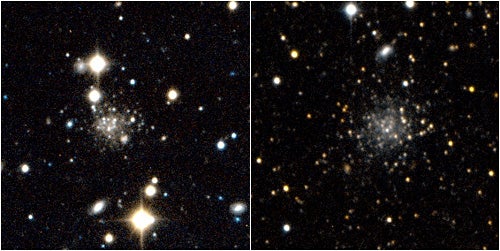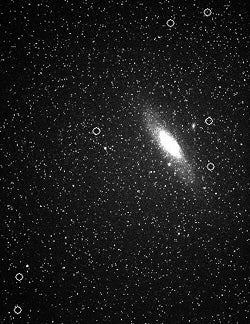Our neighbor galaxy, M31, has at least seven star clusters that appear to be in a class by themselves. The new clusters each contain at least 100,000 stars, bearing a resemblance to globular clusters, but are much larger — spanning hundreds of light-years — and much more spread out.
Astronomers are calling the newly discovered objects “extended clusters.” Nothing like them exists in our own Milky Way Galaxy.
Astronomers uncovered the extended clusters while searching for unknown globular clusters around the galaxy. The new clusters reside in a spherical halo region extending about 200,000 light-years from M31’s disk.
“How these objects formed, and why there are no similar clusters in the Milky Way is still a mystery,” says Avon Huxor, a doctoral candidate at the University of Hertfordshire in England. Huxor will present the finding at the Royal Astronomical Society’s National Astronomy Meeting in Birmingham tomorrow.
“What is clear is that these clusters, like the globulars, are ancient,” says Huxor. “They are billions of years old — possibly amongst the first objects to form in the universe.”
Notes team member Mike Irwin of the University of Cambridge: “It may be they were originally created not in M31, but as part of other small, so-called dwarf galaxies, which have subsequently been pulled apart and merged with the giant M31 galaxy.”
“That would be particularly exciting,” says University of Hertfordshire team member Nial Tanvir. “They might then be more properly considered as the very smallest galaxies rather than star clusters, and help explain the apparent scarcity of such objects compared to theoretical predictions.”
The astronomers used sensitive electronic CCD cameras on the Isaac Newton Telescope at La Palma, Canary Islands, and the Canada-France-Hawaii Telescope in Hawaii to obtain the survey data. A paper announcing the discovery has been submitted to the Monthly Notices of the Royal Astronomical Society.
The Hubble Space Telescope will observe the new clusters later this year.
Extended clusters join the menagerie of star clusters astronomers are struggling to sort out. As discussed in Astronomy‘s current issue, super star clusters — sometimes referred to as young globular clusters — have been seen in many galaxies, but mysteriously also were absent in the Milky Way. Last month, astronomers studying Westerlund 1, a giant star cluster largely hidden behind our galaxy’s dust, concluded it was just such an object — and the most massive, compact young cluster yet seen in the Local Group, the collection of galaxies that includes our own.











